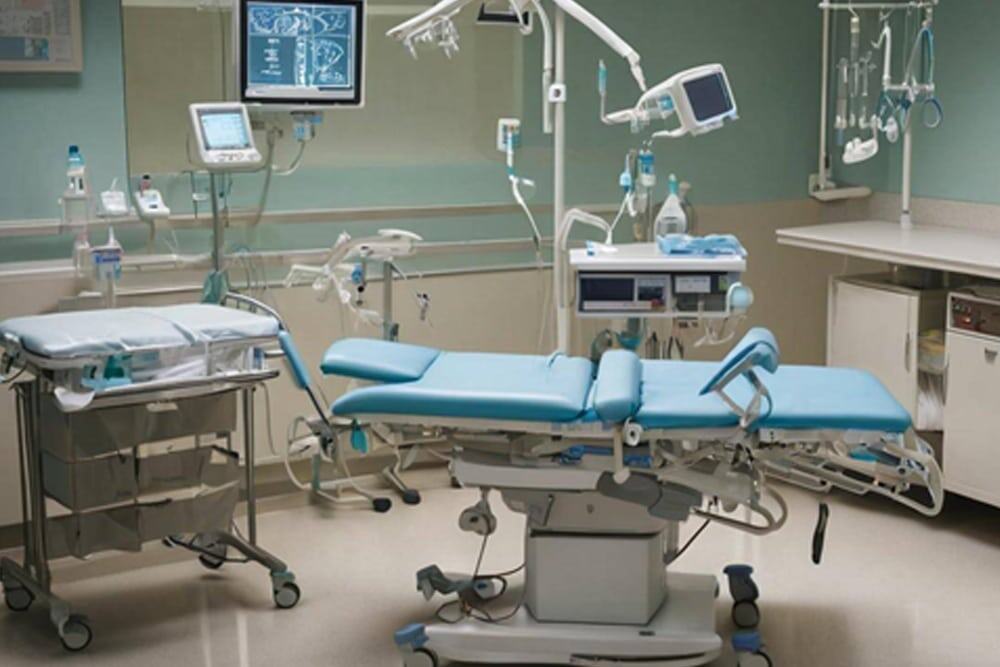Claiming for Fractures During Childbirth in Ireland: A Comprehensive Guide to Your Legal Rights
In Ireland, if childbirth fractures occur due to negligence, you are entitled to make a claim. This is based on the principle that public health services, provided by the Health Service Executive (HSE), must be accountable for any mistakes leading to injury. The twist here is that determining negligence isn't always clear-cut; it involves proving that the HSE or medical professional deviated from established medical standards. Engaging with a seasoned medical negligence solicitor will help streamline this complex process. Let's delve deeper into understanding these legal implications.
The first step is to consult with a medical negligence solicitor who specialises in birth injury cases. They will assess the details of your case and advise you on the potential for a successful claim. If the solicitor believes there are grounds for a claim, they will assist you in gathering evidence, submitting a formal complaint, and pursuing legal action against the responsible party.

The Legal Implications of Childbirth Fractures in Ireland
When it comes to childbirth fractures and the associated legal aspects in Ireland, understanding how medical negligence can lead to serious implications is crucial. While childbirth is often expected to be a joyful and smooth process, complications can arise due to various reasons, including medical errors or negligence during delivery. In Ireland, the Health Service Executive (HSE), as the provider of public health services, plays a central role in these cases. This is where consulting with a legal professional specialising in medical negligence can provide invaluable guidance.
The legal implications of childbirth fractures due to medical negligence extend far beyond seeking financial compensation. It involves assessing the responsibility and accountability of healthcare professionals involved in the childbirth process. Furthermore, it raises important questions about patient safety and the standards of care provided within the healthcare system. These implications highlight the need for thorough investigations, documentation of evidence, and expert legal representation to ensure that the rights of the affected individuals are safeguarded.
In cases involving childbirth fractures resulting from medical negligence, understanding the legal framework becomes essential for pursuing justice and holding responsible parties accountable. It's not just about seeking compensation; it's about advocating for improved patient care standards and preventing similar incidents from occurring in the future.
Navigating through legal proceedings related to childbirth fractures requires a comprehensive understanding of the legal system, including relevant statutes, precedents, and case law specific to medical negligence in Ireland. A specialised legal professional possessing extensive experience in handling medical negligence claims will be well-versed in these intricacies and can provide tailored guidance to individuals seeking to address the legal implications of childbirth fractures.
For instance, a legal professional with expertise in medical negligence can assist individuals by reviewing medical records, consulting with independent medical experts to ascertain the extent of negligence and providing strategic counsel throughout each stage of the legal process. Moreover, they can effectively liaise with healthcare authorities and legal representatives on behalf of their clients, ensuring that their rights are protected, and their concerns are addressed comprehensively.
In essence, navigating through the legal implications of childbirth fractures resulting from medical negligence demands specialised expertise and a deep understanding of the intricacies of medical negligence laws in Ireland. Consulting with a proficient legal professional specialising in this area is crucial for obtaining comprehensive guidance and pursuing appropriate courses of action for addressing such complex matters.
Identifying Negligence in Childbirth Fractures
Childbirth should be a joyous occasion, but when a fracture occurs, it can be traumatic for both the mother and the baby. If you suspect that the fracture was caused by negligence, it's important to understand how to identify it.
Medical Standard of Care
To establish medical negligence in childbirth fractures, it's essential to evaluate whether the healthcare team provided the standard level of care expected during the childbirth process. This includes examining whether there was a failure to diagnose an issue that led to the fracture, improper use of tools during delivery, or not conducting necessary interventions when complications arose.
For instance, if the healthcare providers did not monitor the baby’s positioning adequately during delivery, leading to excessive force being applied and resulting in a fracture, this could be considered a failure to meet the standard of care. It's crucial to note that the standard of care is based on what a reasonably competent healthcare professional with similar training would have done in the same circumstances. Hence, any deviation from this accepted standard could be indicative of negligence.
Expert Opinion
Seeking an expert medical opinion is pivotal in determining whether the fracture could have been avoided with proper medical care and to substantiate claims of negligence in healthcare provision. An experienced medical expert can provide insights into whether the fracture was a result of substandard care or if it was an unforeseeable complication despite appropriate medical intervention.
The expert's evaluation may involve an assessment of the medical records, conducting examinations, and considering existing guidelines and best practises in obstetric care. Their objective perspective plays a crucial role in identifying deviations from the expected standard of care and attributing the cause of the fracture to negligent actions or omissions.
For example, if an expert determines that a fracture resulted from incorrect handling techniques during delivery, which could have been prevented by adhering to established protocols, this assessment can significantly strengthen a claim of medical negligence.
By understanding and evaluating the medical standard of care and seeking expert medical opinions, individuals can effectively identify potential cases of negligence in childbirth fractures and take informed steps towards seeking legal recourse.
Armed with a deeper understanding of how negligence is identified in childbirth fractures, let's now delve into the critical role obstetricians play in injury claims during childbirth.
The Role of Obstetricians in Childbirth Injury Claims

Obstetricians play a pivotal role in childbirth injury claims, as they oversee the entire process of labour and delivery. Their decisions and actions during this process can significantly influence the risk of childbirth fractures and related injuries.
During labour and delivery, obstetricians closely monitor both the mother and the baby to ensure a safe and successful birth. Their expertise is critical in identifying and addressing potential complications that may arise during the birthing process. Additionally, they are responsible for making timely decisions regarding interventions such as caesarean sections or the use of assistive birthing tools like forceps or vacuum extractors.
Moreover, obstetricians are expected to assess the progress of labour and respond promptly if complications, such as foetal distress or prolonged labour, occur. Their ability to make accurate assessments and take appropriate actions in these situations can significantly impact the likelihood of childbirth injuries, including fractures.
For instance, if an obstetrician fails to recognise indicators of foetal distress or delays necessary interventions, it may result in prolonged oxygen deprivation for the baby, increasing the risk of bone fractures and other birth-related injuries. In such cases, their failure to uphold the standard of care could potentially constitute medical negligence.
Furthermore, obstetricians are responsible for properly managing high-risk pregnancies and communicating any potential risks to the expectant parents. Their thorough evaluation of maternal health conditions, foetal well-being, and overall suitability for vaginal delivery is crucial in preventing avoidable birth injuries. This fundamental aspect of their role underscores the importance of comprehensive prenatal care and rigorous assessment protocols throughout pregnancy.
In addition to their clinical responsibilities, obstetricians must maintain accurate documentation of all assessments, interventions, and communications related to each childbirth case. Detailed records play a pivotal role in evaluating the standard of care provided by obstetricians and can serve as crucial evidence when determining liability in childbirth injury claims.
Understanding the multifaceted role of obstetricians in childbirth injury claims is essential for assessing liability and pursuing legal recourse in cases where preventable fractures or injuries occur during childbirth. Their expertise, clinical judgement, decision-making, and communication skills all contribute to ensuring safe deliveries and minimising the risk of birth-related harm.
Now that we've examined the critical role of obstetricians in childbirth injury claims, let's move on to explore the necessary steps for initiating a claim after a childbirth fracture.
Starting Your Claim for a Childbirth Fracture
When beginning the process of filing a claim for a childbirth fracture, seeking legal advice becomes the crucial first step. A medical negligence solicitor possesses the expertise and experience required to guide you through the intricate legal process associated with childbirth injury claims.
Without the counsel of a legal professional, you may find yourself overwhelmed by the complexity and nuances of the legal framework governing childbirth injury claims. The solicitor plays a pivotal role in helping you comprehend your rights and navigate the intricacies of filing a claim, providing invaluable support at every stage of the process.
Upon consulting with a medical negligence solicitor, the next critical step is to gather all relevant medical records and documentation pertaining to the childbirth and the subsequent fractures. These records serve as vital evidence supporting your claim, offering insight into the circumstances surrounding the childbirth and the resulting fractures.
The medical records not only substantiate the occurrence of childbirth fractures but also provide a comprehensive account of the treatment received and any subsequent complications or impacts. This meticulous collection of medical records forms the cornerstone of your claim, offering concrete evidence to fortify your case.
Furthermore, collating comprehensive medical records empowers your legal representation to construct a strategic and compelling case by gaining insightful perspectives into the details and consequences of the childbirth fractures. This diligent compilation enhances their ability to advocate for your rights effectively.
In addition to gathering medical records, it is essential to meticulously assess the damages and losses incurred as a result of the childbirth fractures. This involves detailing both the physical and emotional impact as well as the financial ramifications stemming from these unfortunate events.
Assessing damages encompasses an introspective evaluation of the pain and suffering experienced, potential long-term effects on physical health and emotional well-being, and any financial losses incurred due to medical expenses or diminished earning capacity. By thoroughly assessing damages and losses, you are equipped to comprehensively quantify the extent of your claim, ensuring that your compensation rightfully reflects the full scope of your hardship.
By seeking legal advice, gathering pertinent medical records, and meticulously assessing damages, you strengthen your claim and underscore its significance in safeguarding your rights and pursuing rightful compensation.
Symptoms and Impacts of Childbirth Fractures
When it comes to childbirth fractures, understanding the symptoms and impacts is crucial. Visible deformities in the affected area can be a significant indicator; however, in some cases, the fracture might not displace the bone or cause a noticeable change in shape, making it vital for medical professionals to conduct thorough examinations.
Moreover, limited range of motion is often a key symptom. The affected limb or area may display stiffness or restricted movement due to the fracture, impacting daily activities and overall quality of life for both the child and their caregivers.
Chronic pain is another common outcome of childbirth fractures. The ongoing discomfort experienced by the child can lead to a significant decrease in their ability to enjoy regular activities, affecting their emotional well-being as well. This long-term impact underscores the necessity for comprehensive medical and legal attention.
It's imperative for legal claims to fully encompass these long-term effects. Medical assessments should thoroughly document these symptoms and impacts, ensuring that all aspects of the child's well-being are considered. Neglecting any of these could potentially result in inadequate compensation for the child's hardship and suffering.
Understanding these symptoms paves the way for an assessment of the extent of the damages incurred by childbirth fractures, facilitating appropriate legal action to hold responsible parties accountable. This is not just about seeking compensation; it's about acknowledging and addressing the profound impact these fractures have on a child's life.
Caring for a child who has experienced a childbirth fracture involves addressing not just the physical symptoms but also considering their emotional well-being. In the next section, we'll explore this critical aspect of support and care for both medical and legal purposes.
Comprehensive Guide to Legal Rights in Childbirth Injury Claims
Filing a claim for childbirth fractures and injuries can be overwhelming, but understanding your legal entitlements is crucial for obtaining the support you and your family deserve. When it comes to childbirth injury claims, there are specific legal entitlements that individuals or families may have.
- Medical Expenses Compensation: If you or your child has sustained fractures during childbirth due to negligence, you may be entitled to compensation for medical expenses related to the diagnosis, treatment, and rehabilitation of the injuries. This includes costs associated with surgeries, hospital stays, medication, physical therapy, and any other necessary medical intervention.
- Ongoing Care Compensation: In addition to covering past medical expenses, childbirth injury claims may also provide compensation for ongoing care needs resulting from the fracture. This encompasses the cost of future medical treatments, therapies, assistive devices, and any accommodations required to support the individual's wellbeing and quality of life.
- Emotional Distress Damages: Childbirth injuries can have a lasting impact on both the child and the family. Emotional distress damages aim to compensate for the emotional suffering experienced as a result of the injury. This can include psychological support, counselling expenses, and other forms of emotional assistance.
Understanding these legal entitlements is an essential step in seeking justice and securing support for the challenges posed by childbirth fractures. It's important to consult with legal professionals specialising in medical negligence to fully grasp the extent of your entitlements and work towards a fair resolution.
Statute of Limitations
In any legal claim, timing is critical. It's necessary to understand the statute of limitations for filing claims in childbirth injury cases in order to protect your rights. The statute of limitations establishes a timeframe within which a lawsuit must be initiated after the occurrence of an injury.
In Ireland, the statute of limitations for personal injury claims, including childbirth fractures, is typically two years from the date of knowledge or when one becomes aware that the injury was significant and related to medical negligence. However, there are exceptions and variations depending on each case's circumstances, making it imperative to seek legal counsel at the earliest opportunity following an injury.
Having an awareness of the statute of limitations allows claimants to take prompt legal action without risking potential time constraints that may hinder their ability to seek rightful compensation and recourse.
Equipping yourself with this knowledge ensures that you are well-informed about your rights and can make informed decisions about pursuing a childbirth injury claim. Seeking legal guidance early on is paramount to comprehending the nuances of your legal entitlements and navigating the complexities of filing a claim within the stipulated timeframe.
Get a Consultation Today! - Call us now at 01 5134687
Gary Matthews Solicitors
Medical negligence solicitors, Dublin
We help people every day of the week (weekends and bank holidays included) that have either been injured or harmed as a result of an accident or have suffered from negligence or malpractice.
Contact us at our Dublin office to get started with your claim today

